

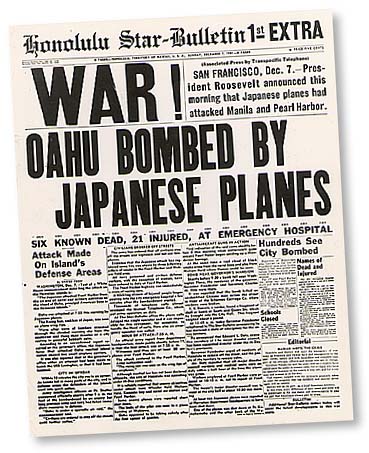
Hawaii for the ages
War comes to the islands
1939
April: Navy holds biggest war games to date here.
May 18: Honolulu's first blackout drill lasts 20 minutes.
Aug. 1: FBI's Honolulu office reopens to work with Army and Navy on possible spying incidents.
1940
April: 130 ships of U.S. Fleet arrive. Also: U.S. Secretary of Navy calls inspection of Army and Navy facilities here "completely reassuring."
May 23: Entire Territory participates in blackout drill.
August: Fingerprinting of aliens begins under federal Alien Registration Act. Also: Navy plans for its largest Pacific air base, on 2,700 acres at Barbers Point, plus expanding Kaneohe NAS by acquiring Mokapu Peninsula.
Nov. 5: Defense workers arrive for Pearl Harbor and Midway.
1941
May: Army sends 21 "Flying Fortresses" here.
June: Army plans $750,000 food storage tunnel near Fort Shafter. Also: Honolulu blood bank gets first donor.
July 26: Many here affected as U.S. freezes Japanese and Chinese assets; Japan, in turn, freezes U.S. funds there.
Sept. 1: Up to 8,000 unionists march in Labor Day parade, largest labor gathering in Territory's history.
November: Despite expressing hope to reporters here en route to Washington, D.C., Japan's special envoy weeks later rejects U.S.'s settlement deal. On Nov. 27, a U.S. "war warning" arrives, advising that hostile action can be expected.
Dec. 7: Japan attacks Pearl Harbor, plunging United States into World War II. USS Arizona and other ships are sunk; more than 2,500 lives are lost. Martial law in Hawaii is declared. On Dec. 8, schools taken over for evacuation centers, hospitals, defense purposes.
Dec. 15: Kahului, Maui, shelled by Japanese sub.
Dec. 18: Military orders farmers near West Loch evacuated. The next day, all residents evacuated from Iwilei.
Dec. 30-31: Japanese subs shell the ports of Hilo, Big Island; Nawiliwili, Kauai; and Kahului, Maui.
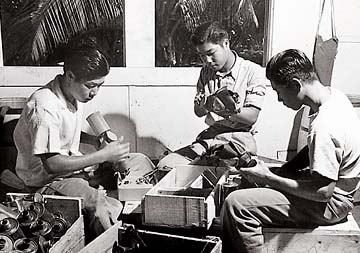
1942
January: $15 million in federal civilian defense money arrives; distribution of gask masks begins; commission report blames U.S. Dec. 7 losses on military commanders' lack of alertness. On Jan. 28, Army transport Royal T. Frank is torpedoed by Japanese sub between Hawaii and Maui, killing dozens.
February 1942: President Franklin D. Roosevelt signs Executive Order 9066, declaring all people of Japanese descent be moved from California, Oregon, Washington. Some 112,000 ousted from homes and businesses.
Feb. 21: People of Japanese, German and Italian ancestry ordered to turn in firearms, explosives, other weapons.
March 4: Three bombs hit Tantalus.
May 10: Mauna Loa eruption threatens Hilo defense facilities.
June 5: Adm. Chester Nimitz announces defeat of Japan fleet at Battle of Midway.
Summer: 1,300 Japanese-American volunteers leave for Camp McCoy, Wis., to train as 100th Infantry Battalion; nine months later, this "Purple Heart Battalion" merges with 442nd Regimental Combat Team.
August: Ingram M. Stainback appointed governor.
Nov. 23: First group of 107 Hawaii Japanese arrive at Jerome Relocation Center, Ark.
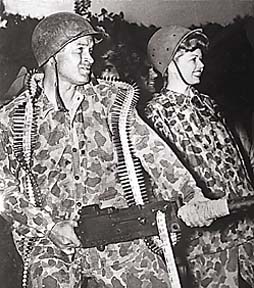
1943
Jan. 20: White House announces civilian authority of some government functions restored, though martial law remains in effect. A March ceremony marks this change.
March 28: 15,000 attend program for 2,600 AJA volunteer Army soliders leaving for Camp Shelby, Miss.
May 18: 5,000 Koreans petition to have status changed from enemy to friendly aliens. In December, that occurs.
July 13: Blackout rules ease to allow lights in homes until 10 p.m., except for rooms facing the sea.
Aug. 8: Waikiki off-limits to servicemen due to dengue fever epidemic; ban is lifted Sept. 13.
September: Eleanor Roosevelt tours Oahu for several days. Also: The 100th Battalion begins action in Italy.
December: 2nd Marine Division, after Guadalcanal and Tarawa fighting, comes here for rest and training en route to Marianas.
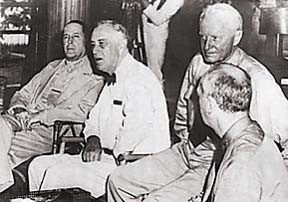
1944
March: First company of WACs arrive. Also: Commercial rent control established on Oahu.
May 21: Explosion of LSTs in Pearl Harbor kills 127, injures 380.
May-June: Troops leave for Saipan, Tinian and Guam.
June 8: Ten civilians and four Army men killed, and 15 civilians hurt when two Army planes collide, crash in Kalihi.
July 19: Democratic National Convention endorses statehood for Hawaii.
July: President Roosevelt makes five-day visit here for military conference.
Oct. 24: Martial law here formally ends.
October: 442nd Regimental Combat Team liberates French towns of Bruyeres and Biffontaine from Nazis, rescues "Lost Battalion."
Sept. 21: Gov. Stainback orders Honolulu brothels closed.
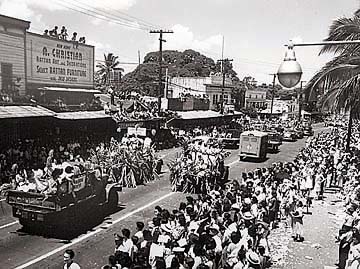
1945
January: Troops leave for Iwo Jima and Okinawa; CINCPAC moves from Pearl Harbor to Guam, closer to the action fields.
Feb. 18: First of many U.S. POW groups released from Philippines and Japan arrive, en route to mainland.
Feb. 19: Emergency federal housing, Kalihi War Homes, is occupied. Three months later, federal government takes 83-acre Manoa site for more units.
May 8: End of hostilities in Europe.
June 6-10: Honolulu diary workers' strike begins series of strikes.
July 7: Curfew lifted.
Aug. 3: First negotiated labor contract in agriculture, between sugar growers and ILWU.
Aug. 6: U.S. drops atomic bomb on Hiroshima, instantly killing at least 70,000; another a-bomb is dropped on Nagasaki on Aug. 9.
Aug. 14: Japan surrenders; huge "V-J Day" celebrations mark end of WWII. Next day, gas rationing, labor controls and censorship end.
September: On Sept. 2, Japanese signs surrender documents, aboard the USS Missouri docked in Tokyo Bay. Hawaii officially marks V-J Day with three-day holiday ending with big victory parade.
Nov. 14: First large group of Hawaii AJAs interned, 450 of them, return.
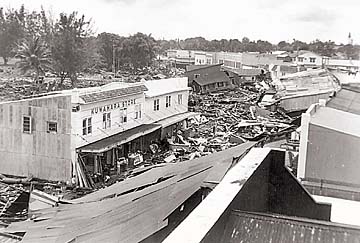
1946
Jan. 7: Eleven years after initial hearings here, subcommittee of U.S. Committee on Territories holds hearings, recommends legislation be considered to admit Hawaii as state. But U.S. Senate would oppose that for next decade.
Feb. 25: U.S. Supreme Court, 6-2, declares martial law in Hawaii was unconstitutional and illegal.
April 1: Tsunami slams into Hilo, killing 159, injuring some 160, causing $25 million damage.
July: Trans Pacific Airlines founded; becomes Aloha Airlines in 1958.
Sept. 10: Hawaii Air National Guard established.
The Honolulu Star-Bulletin is counting down to year 2000 with this special series. Each month through December, we'll chronicle important eras in Hawaii's history, featuring a timeline of that particular period. Next month's installment: October 18. About this Series
Series Archive
Project Editor: Lucy Young-Oda
Graphics by Bryant Fukutomi and Lucy Young-Oda